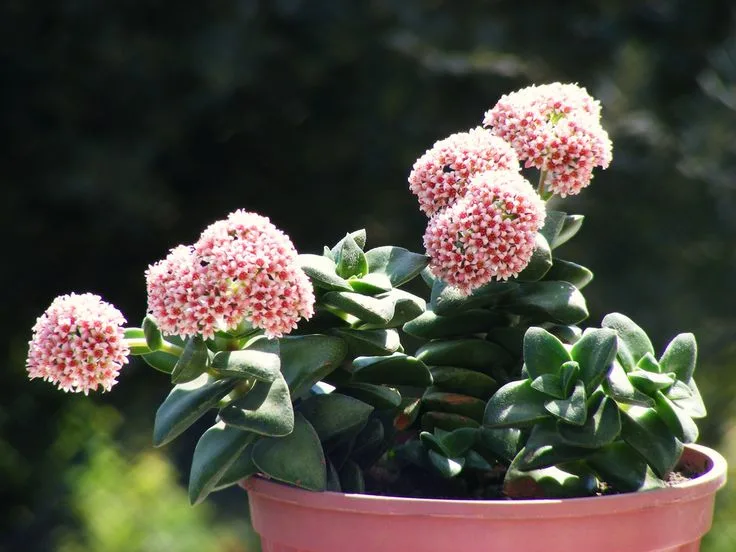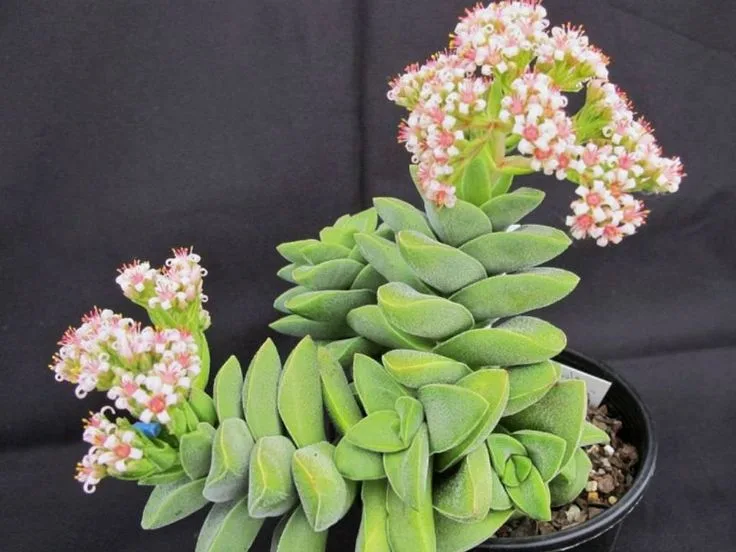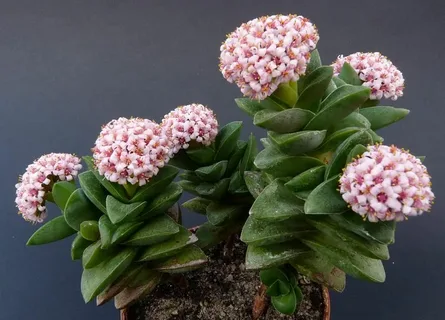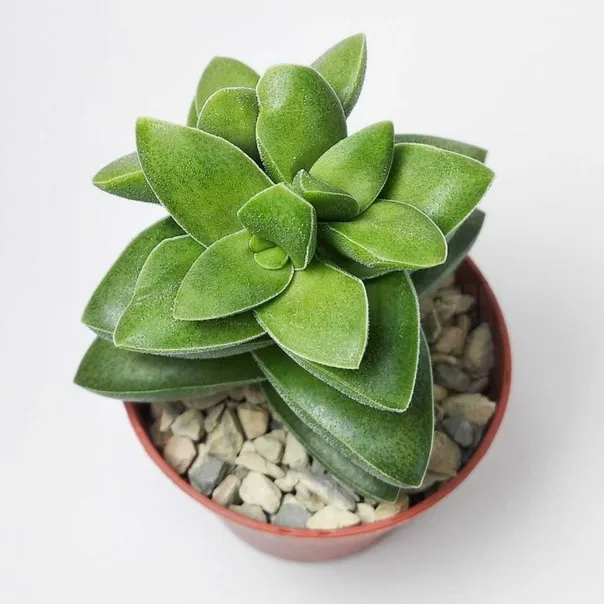Index
Introduction
The Crassula Springtime is a charming and popular succulent, known for its vibrant green leaves and reddish edges. Originally from South Africa, this plant is appreciated not only for its ornamental beauty, but also for its easy maintenance and ability to thrive in a variety of conditions. Its fleshy, rounded leaves grow in dense clusters, creating a lush and attractive appearance. During the warmer months, Crassula Springtime can produce small white or pink flowers, adding even more charm to its visual appeal.
Meaning of Crassula Springtime
In addition to its aesthetic beauty, the Crassula Springtime carries symbolic meanings. In the language of flowers, this succulent is associated with renewal, growth and vitality, reflecting the energy and beauty of spring. Having a Crassula Springtime in your home not only adds a touch of freshness and color to the room, but also symbolizes rebirth and hope for the future.
| Item | Item Information |
|---|---|
| Common Name | Crassula Springtime |
| Botanical Name | Crassula ovata ‘Springtime’ |
| Family | Crassulaceae |
| Plant Type | Succulent |
| Adult Size | Up to 30 cm tall |
| Sun exposure | Direct or indirect sunlight |
| Soil type | Well-drained |
| soil pH | Slightly acidic to neutral (6.0 – 7.0) |
| Flowering Season | Spring |
| Flower Color | White or pink |
| Native Area | South Africa |
| Toxicity | Non-toxic |

How to Care for Crassula Springtime
Discover the essential care to keep your Crassula Springtime healthy and lush.
Light
Crassula Springtime thrives in places with direct or indirect sunlight. Make sure you position it in a place where it gets enough light during the day, but avoid direct exposure to the strong midday sun to prevent burns on the leaves.
Soil
Well-drained soil is essential for the successful cultivation of Crassula Springtime. Use a soil mixture for succulents or cacti, adding sand or perlite to improve drainage. Avoid compacted soil that can retain excess water.
Water
Like many succulents, Crassula Springtime prefers a moderate watering regime. Let the soil dry out between waterings to avoid excess moisture, which can lead to root rot. Water directly into the soil, avoiding wetting the leaves to prevent fungal diseases.
Temperature and humidity
This succulent is adaptable to a wide range of temperatures, but prefers moderate to warm climates. Keep the room temperature between 15°C and 25°C and avoid exposure to cold drafts. As for humidity, Crassula Springtime tolerates moderate levels, but avoid excessively humid environments to prevent problems such as powdery mildew and root rot.
Fertilizing
Fertilizing Crassula Springtime should be done sparingly. Use a diluted balanced fertilizer specifically for succulents during spring and summer. Avoid fertilizing during the winter months, when the plant is resting. Always follow the manufacturer’s instructions to avoid excess nutrients, which can be harmful to the plant.

How to Make Crassula Springtime Cuttings
Here are the simple steps to propagate your Springtime Crassula through cuttings:
How to Make Cuttings
- Selecting the Mother Plant: Choose a healthy, mature plant as the mother plant for your cuttings. Make sure it shows no signs of disease or damage.
- Cutting the cuttings: With clean, sharp scissors, make clean cuts in the healthy stems of the mother plant. Cut cuttings about 5 to 10 centimeters long, removing the lower leaves to create a clean stem.
- Drying the cuttings: Leave the cuttings to dry in a cool, shaded place for a few days. This allows the cut ends to heal, reducing the risk of fungal infection when they are planted.
- Planting the cuttings: After drying, plant the cuttings in a light, well-drained substrate, such as a soil mix for succulents. Bury the cuttings deep enough so that they are firm in the soil, but keep the top exposed.
- Post-planting care: Keep the soil slightly moist and place the cuttings in a spot with indirect light. Avoid overwatering to prevent the cuttings from rotting. In a few weeks, the cuttings should develop roots and begin to grow.
How to plant Crassula Springtime
Preparing the soil:
- Site selection: Choose a spot with direct or indirect sunlight to plant your Crassula Springtime cuttings. Make sure the soil is well-drained to avoid water accumulating around the roots.
- Soil preparation: Prepare the soil by removing debris and weeds. If necessary, add sand or perlite to improve the drainage and aeration of the soil.
Planting the cuttings:
- Transplanting the cuttings: When transplanting the rooted cuttings, dig small holes in the soil and plant the cuttings, gently pressing the soil around them. Make sure you leave enough space between the cuttings to allow for future growth.
- Initial watering: After planting, water the cuttings carefully to help establish the roots. Avoid over-watering, as the seedlings are still adapting to their new environment.
- Aftercare: Continue to monitor your Crassula Springtime seedlings, watering as necessary and providing adequate light. Over time, your seedlings will grow into mature, healthy plants.

Most common pests and diseases
Discover the pests and diseases that can affect your Crassula Springtime:
- Mealybugs: Small insects that feed on plant sap, leaving behind a sticky substance called honeydew.
- Mites: Microscopic pests that can cause damage to leaves, resulting in spots and discoloration.
- Root rot: Caused by excess moisture in the soil, which can lead to root rot.
- Powdery mildew: A fungus that manifests itself as a layer of white powder on leaves and stems.
- Stem canker: A bacterial infection that causes lesions on the plant’s stems.
- Wilt: Caused by a soil fungus, resulting in wilting and death of the affected parts of the plant.
Common Problems and Their Solutions
Here are some solutions to the most common problems faced by Crassula Springtime:
Mealybugs:
- Solution: Remove the mealybugs manually with a cotton swab soaked in alcohol. If the infestation is severe, consider using an insecticide specifically for mealybugs.
Mites:
- Solution: Apply a strong jet of water to the leaves to remove the mites. If necessary, use a mineral oil or insecticidal soap to control the infestation.
Root rot:
- Solution: Reduce the frequency of watering and make sure the soil has good drainage. Remove the affected parts of the plant and replant in new soil if necessary.
Powdery mildew:
- Solution: Remove the affected parts of the plant and apply a specific fungicide for powdery mildew. Make sure to improve air circulation around the plant to avoid favorable conditions for the fungus.
Stem canker:
- Solution: Remove the affected parts of the plant with sterilized scissors. Apply a bactericidal fungicide to prevent the infection from spreading.
Wilt:
- Solution: Discard infected plants to prevent the spread of the disease. Make sure you plant in well-drained soil and avoid excess moisture. Use crop rotation to avoid re-infecting the soil.

Curiosities and myths
Discover interesting facts and dispel the myths surrounding Crassula Springtime:
Curiosities:
- Exotic origin: Crassula Springtime is native to South Africa, where it grows in arid, sunny environments.
- Enduring Beauty: Its succulent, glossy leaves remain vibrant all year round, making it a standout plant in any garden or succulent collection.
- Delicate flowers: During spring, Crassula Springtime can produce small white or pink flowers, adding a touch of elegance to its already charming look.
Myths:
- Luck and Prosperity: Some people believe that having a Crassula Springtime in the house brings good luck and prosperity to the home and is considered a good luck charm.
- Protective Power: Some myths suggest that this succulent is able to protect against negative energies and bad vibes, serving as a spiritual guard for the environment in which it is present.
- Ease of Cultivation: Although it is an easy plant to care for, there is a myth that the Crassula Springtime is so hardy that it can survive even in adverse conditions, making it an ideal choice for beginner gardeners.
Conclusion
In short, the Crassula Springtime is much more than just an ornamental plant – it’s a symbol of beauty, luck and protection. Originally from South Africa, this succulent enchants with its glossy leaves and its ability to bloom during the spring. What’s more, the myths surrounding it, such as its power to attract good luck and ward off negative energies, add a special charm to its presence in the home or garden.
By growing a Crassula Springtime, you not only add a touch of green to your space, but you also invite renewal, prosperity and protection to become part of your environment. With simple care and attention to detail, this succulent can flourish and bring a sense of harmony and well-being wherever it is planted.
Frequently asked questions
How to water Crassula?
When watering Crassula, it is important to follow a moderate watering regime. Let the soil dry out completely between waterings and avoid wetting the leaves directly. Too much water can lead to root rot, so it is essential to avoid waterlogging the soil.
What are the types of Crassula?
There are several types of Crassula, each with unique characteristics. Some examples include Crassula ovata (jade plant), Crassula muscosa (stone moss), Crassula perforata (stacked leaves) and Crassula arborescens (money tree). Each type has different growth forms, colors and care requirements.
How to look after a Crassula?
To care for a Crassula, it is important to provide it with direct or indirect sunlight and well-drained soil. Water moderately, letting the soil dry out between waterings, and avoid excess moisture. Keep the plant at a moderate room temperature and protect it from cold drafts. Also, fertilize sparingly during spring and summer to promote healthy growth.







